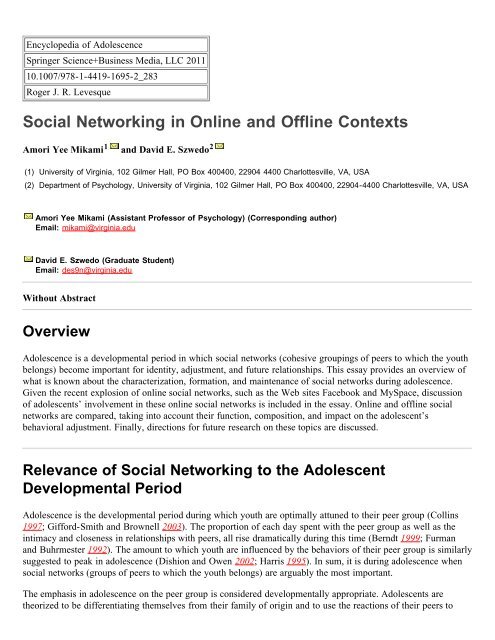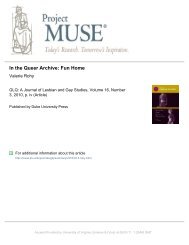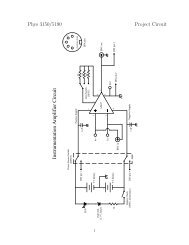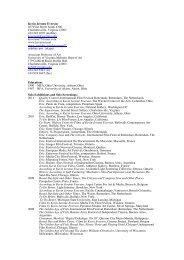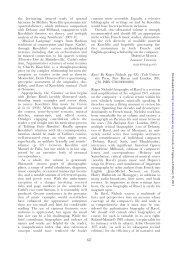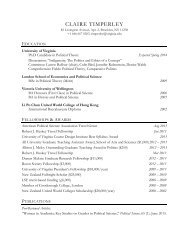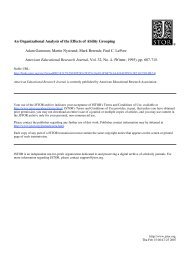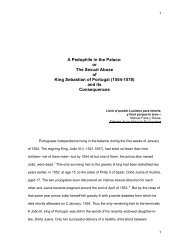Social Networking in Online and Offline Contexts - University of ...
Social Networking in Online and Offline Contexts - University of ...
Social Networking in Online and Offline Contexts - University of ...
Create successful ePaper yourself
Turn your PDF publications into a flip-book with our unique Google optimized e-Paper software.
Encyclopedia <strong>of</strong> Adolescence<br />
Spr<strong>in</strong>ger Science+Bus<strong>in</strong>ess Media, LLC 2011<br />
10.1007/978-1-4419-1695-2_283<br />
Roger J. R. Levesque<br />
<strong>Social</strong> <strong>Network<strong>in</strong>g</strong> <strong>in</strong> Onl<strong>in</strong>e <strong>and</strong> Offl<strong>in</strong>e <strong>Contexts</strong><br />
Amori Yee Mikami 1 <strong>and</strong> David E. Szwedo 2<br />
(1) <strong>University</strong> <strong>of</strong> Virg<strong>in</strong>ia, 102 Gilmer Hall, PO Box 400400, 22904 4400 Charlottesville, VA, USA<br />
(2) Department <strong>of</strong> Psychology, <strong>University</strong> <strong>of</strong> Virg<strong>in</strong>ia, 102 Gilmer Hall, PO Box 400400, 22904-4400 Charlottesville, VA, USA<br />
Amori Yee Mikami (Assistant Pr<strong>of</strong>essor <strong>of</strong> Psychology) (Correspond<strong>in</strong>g author)<br />
Email: mikami@virg<strong>in</strong>ia.edu<br />
David E. Szwedo (Graduate Student)<br />
Email: des9n@virg<strong>in</strong>ia.edu<br />
Without Abstract<br />
Overview<br />
Adolescence is a developmental period <strong>in</strong> which social networks (cohesive group<strong>in</strong>gs <strong>of</strong> peers to which the youth<br />
belongs) become important for identity, adjustment, <strong>and</strong> future relationships. This essay provides an overview <strong>of</strong><br />
what is known about the characterization, formation, <strong>and</strong> ma<strong>in</strong>tenance <strong>of</strong> social networks dur<strong>in</strong>g adolescence.<br />
Given the recent explosion <strong>of</strong> onl<strong>in</strong>e social networks, such as the Web sites Facebook <strong>and</strong> MySpace, discussion<br />
<strong>of</strong> adolescents’ <strong>in</strong>volvement <strong>in</strong> these onl<strong>in</strong>e social networks is <strong>in</strong>cluded <strong>in</strong> the essay. Onl<strong>in</strong>e <strong>and</strong> <strong>of</strong>fl<strong>in</strong>e social<br />
networks are compared, tak<strong>in</strong>g <strong>in</strong>to account their function, composition, <strong>and</strong> impact on the adolescent’s<br />
behavioral adjustment. F<strong>in</strong>ally, directions for future research on these topics are discussed.<br />
Relevance <strong>of</strong> <strong>Social</strong> <strong>Network<strong>in</strong>g</strong> to the Adolescent<br />
Developmental Period<br />
Adolescence is the developmental period dur<strong>in</strong>g which youth are optimally attuned to their peer group (Coll<strong>in</strong>s<br />
1997; Gifford-Smith <strong>and</strong> Brownell 2003). The proportion <strong>of</strong> each day spent with the peer group as well as the<br />
<strong>in</strong>timacy <strong>and</strong> closeness <strong>in</strong> relationships with peers, all rise dramatically dur<strong>in</strong>g this time (Berndt 1999; Furman<br />
<strong>and</strong> Buhrmester 1992). The amount to which youth are <strong>in</strong>fluenced by the behaviors <strong>of</strong> their peer group is similarly<br />
suggested to peak <strong>in</strong> adolescence (Dishion <strong>and</strong> Owen 2002; Harris 1995). In sum, it is dur<strong>in</strong>g adolescence when<br />
social networks (groups <strong>of</strong> peers to which the youth belongs) are arguably the most important.<br />
The emphasis <strong>in</strong> adolescence on the peer group is considered developmentally appropriate. Adolescents are<br />
theorized to be differentiat<strong>in</strong>g themselves from their family <strong>of</strong> orig<strong>in</strong> <strong>and</strong> to use the reactions <strong>of</strong> their peers to
assist them <strong>in</strong> creat<strong>in</strong>g their own identity (Adler <strong>and</strong> Adler 1998; Brown 2004; Brown et al. 1986). Moreover, the<br />
templates that peer relationships establish <strong>in</strong> adolescence may become critical to set the stage for healthy<br />
socializ<strong>in</strong>g <strong>in</strong> adulthood (Sullivan 1953). In fact, longitud<strong>in</strong>al work suggests that qualities <strong>of</strong> peer <strong>in</strong>teractions <strong>in</strong><br />
early adolescence are repeated <strong>in</strong> young adult relationships with romantic partners (Stocker <strong>and</strong> Richmond 2007)<br />
<strong>and</strong> friends (Bagwell et al. 1998; Eisenberg et al. 2002). Collectively, these f<strong>in</strong>d<strong>in</strong>gs underscore the particular<br />
importance <strong>of</strong> social networks dur<strong>in</strong>g the adolescent period.<br />
<strong>Social</strong> Network Theory<br />
Adolescents’ peer <strong>in</strong>teractions may be characterized <strong>in</strong> multiple ways, but this essay focuses on a particular aspect<br />
<strong>of</strong> the relationship with the peer group known as the social network. <strong>Social</strong> networks, sometimes referred to as<br />
cliques, are cohesive groups <strong>of</strong> youth who <strong>in</strong>teract more with one another than with other youth (Adler <strong>and</strong> Adler<br />
1998; Urberg et al. 1995). <strong>Social</strong> networks may be organized around participation <strong>in</strong> common activities, such as<br />
study<strong>in</strong>g or skateboard<strong>in</strong>g, or may simply be def<strong>in</strong>ed by common friendships. Most importantly, however, these<br />
networks typically provide a social sett<strong>in</strong>g <strong>in</strong> which adolescents spend time together, form close ties, <strong>and</strong> learn<br />
<strong>in</strong>terpersonal skills that are important <strong>in</strong> both adolescence <strong>and</strong> adulthood (Brown 2004).<br />
Adolescents’ social networks are structurally different from the crowds that frequently typify high schools.<br />
Whereas social networks are comprised <strong>of</strong> adolescents who actually hang out together, crowds are reputationbased<br />
groups, whose members may or may not consider each other friends, such as “the bra<strong>in</strong>s, the jocks, the<br />
geeks, the popular crowd” (Adler <strong>and</strong> Adler 1998; Gest et al. 2007a). Thus, crowds <strong>of</strong>ten def<strong>in</strong>e the social<br />
structure <strong>of</strong> schools, sometimes help<strong>in</strong>g adolescents to classify hierarchies with<strong>in</strong> the peer group (Brown 2004).<br />
However, because crowd membership is not necessarily based on actual <strong>in</strong>teractions or affiliations among peers,<br />
these groups are likely to contribute more to the teens’ sense <strong>of</strong> identity than the development <strong>of</strong> their social skills<br />
(Ste<strong>in</strong>berg 2005).<br />
<strong>Social</strong> networks are also different from dyadic friendships (close, mutual relationships between two youth) <strong>in</strong> that<br />
networks may provide adolescents with group support <strong>and</strong> a sense <strong>of</strong> a collective identity as a group member,<br />
which dyadic friendships may not <strong>of</strong>fer (Gifford-Smith <strong>and</strong> Brownell 2003). <strong>Social</strong> networks can also be<br />
dist<strong>in</strong>guished from sociometric status (be<strong>in</strong>g globally regarded as liked by the peer group at large) because social<br />
networks assess adolescents’ actual <strong>in</strong>teractions <strong>and</strong> affiliations with peers, whereas sociometric status measures<br />
perceptions <strong>of</strong> lik<strong>in</strong>g (Gifford-Smith <strong>and</strong> Brownell 2003). For <strong>in</strong>stance, an adolescent could have a strong, tightknit<br />
social network <strong>of</strong> a few close peers, while be<strong>in</strong>g broadly considered as unpopular by the rest <strong>of</strong> the school.<br />
That said, past research has found positive correlations between the likelihood that someone is a member <strong>of</strong> a<br />
social network <strong>and</strong> the presence <strong>of</strong> dyadic friendship <strong>and</strong> high sociometric popularity (Gest et al. 2001; Wentzel<br />
<strong>and</strong> Caldwell 1997). Nonetheless, correlations are modest, underscor<strong>in</strong>g the need to assess social networks as a<br />
dist<strong>in</strong>ct construct from dyadic friendships <strong>and</strong> sociometric status (Gest et al. 2001).<br />
In the field <strong>of</strong> psychology, social networks are typically assessed us<strong>in</strong>g sociometric nom<strong>in</strong>ation measures where,<br />
for example, adolescents are asked to name the “people they hang out with” from their grade at school (Cairns et<br />
al. 1988; Gest et al. 2007b). <strong>Social</strong> networks can then be identified by compar<strong>in</strong>g the nom<strong>in</strong>ations for everyone at<br />
that grade level to f<strong>in</strong>d the presence <strong>of</strong> consistent group<strong>in</strong>gs. Adolescents may also be asked to list “the people<br />
they hang out with together,” <strong>in</strong> addition to list<strong>in</strong>g the people with whom they associate personally, which is a<br />
way to compensate for hav<strong>in</strong>g miss<strong>in</strong>g participants <strong>in</strong> a sample (Gest 2007). Computerized s<strong>of</strong>tware such as<br />
Kliquef<strong>in</strong>der (Frank 1995, 1996) may be used to process the sociometric nom<strong>in</strong>ation <strong>in</strong>formation us<strong>in</strong>g a<br />
cluster<strong>in</strong>g algorithm <strong>in</strong> order to group participants <strong>in</strong>to social networks. Observational studies suggest that the<br />
social networks determ<strong>in</strong>ed from sociometric nom<strong>in</strong>ations do correlate with visible patterns <strong>of</strong> <strong>in</strong>teraction; for<br />
example, members <strong>of</strong> the same social network were recorded by <strong>in</strong>dependent observers to <strong>in</strong>teract with one<br />
another four times more <strong>of</strong>ten than with other same-sex adolescents not found to be <strong>in</strong> their social network (Gest
et al. 2003).<br />
Importantly, although sociometrics are considered the st<strong>and</strong>ard procedure <strong>in</strong> the field for assess<strong>in</strong>g social<br />
networks, limitations to this methodology do exist. One key limitation is that this method only maps social<br />
networks that an <strong>in</strong>dividual has with<strong>in</strong> a set context such as school. This is because this procedure requires a<br />
majority <strong>of</strong> <strong>in</strong>dividuals <strong>in</strong> a s<strong>in</strong>gle context to report on everyone’s networks (e.g., all the students <strong>in</strong> one grade at<br />
a s<strong>in</strong>gle high school report on the social networks <strong>in</strong> that grade level). However, unlike among children for whom<br />
their primary peer relationships are <strong>in</strong> the classroom, <strong>in</strong> adolescence many important relationships are formed with<br />
<strong>in</strong>dividuals who do not attend the same school (Keisner et al. 2003; Poul<strong>in</strong> <strong>and</strong> Pedersen 2007). Thus, although<br />
sociometric procedures provide <strong>in</strong>formation about social networks with<strong>in</strong> a particular context, they do not<br />
consider adolescents’ broader affiliations with peers. For <strong>in</strong>stance, an adolescent could have a strong social<br />
network <strong>of</strong> a few peers outside school (e.g., <strong>in</strong> the neighborhood or church), while be<strong>in</strong>g isolated <strong>in</strong> his or her<br />
school.<br />
<strong>Social</strong> networks vary <strong>in</strong> size, cohesiveness, stability, <strong>and</strong> centrality (Gest et al. 2007a). First, most social networks<br />
are thought to have about four to five members, but variability exists with some be<strong>in</strong>g significantly larger or<br />
smaller (Gest et al. 2007b). Second, social networks can vary on how tight knit <strong>and</strong> exclusive they are, sometimes<br />
referred to as the density <strong>of</strong> the social network versus diffuse <strong>in</strong> boundaries. Third, just as <strong>in</strong> friendships, some<br />
social networks are highly stable whereas <strong>in</strong> others, members come <strong>and</strong> go. F<strong>in</strong>ally, centrality is a term used to<br />
describe whether the social network is perceived to be <strong>in</strong>fluential <strong>and</strong> socially dom<strong>in</strong>ant <strong>in</strong> the organization at<br />
large, with members who are well connected with many other groups versus whether the social network is a<br />
marg<strong>in</strong>alized group.<br />
Research about what causes adolescents to form the social networks they do has generally suggested homophily<br />
as a guid<strong>in</strong>g pr<strong>in</strong>ciple (McPherson et al. 2001). That is, adolescents are drawn to form social networks with peers<br />
who are similar to themselves. Importantly, homophily <strong>in</strong> social network membership exists for a broad range <strong>of</strong><br />
constructs, <strong>in</strong>clud<strong>in</strong>g <strong>in</strong>terests, attitudes, status, <strong>and</strong> also <strong>in</strong> regard to drug <strong>and</strong> alcohol use, externaliz<strong>in</strong>g problems,<br />
<strong>and</strong> <strong>in</strong>ternaliz<strong>in</strong>g problems (Cairns et al. 1988; Hogue <strong>and</strong> Ste<strong>in</strong>berg 1995).<br />
Onl<strong>in</strong>e <strong>Social</strong> Networks<br />
Although traditional <strong>in</strong>vestigations <strong>of</strong> social network<strong>in</strong>g have relied upon networks represent<strong>in</strong>g face-to-face<br />
relationships among adolescents <strong>in</strong> a s<strong>in</strong>gle school, explosive growth has occurred <strong>in</strong> recent years <strong>in</strong> onl<strong>in</strong>e social<br />
communication (Madden 2006). Importantly, adolescents are the age group disproportionately affected by this<br />
new technology (Pew Internet <strong>and</strong> American Life Project 2009). While Internet use is now common among all<br />
age groups, it is adolescents who predom<strong>in</strong>ately use the social communication functions <strong>of</strong> the Internet, that is, to<br />
make <strong>and</strong> ma<strong>in</strong>ta<strong>in</strong> relationships with peers onl<strong>in</strong>e (Bargh <strong>and</strong> McKenna 2004).<br />
<strong>Social</strong> network<strong>in</strong>g Web sites, the most popular <strong>of</strong> which are Facebook <strong>and</strong> MySpace, exemplify onl<strong>in</strong>e social<br />
communication. Both orig<strong>in</strong>ated <strong>in</strong> 2003–2004 but together they have approximately 230 million unique active<br />
users every month worldwide (TechCrunch 2008). On both <strong>of</strong> these Web sites, users ma<strong>in</strong>ta<strong>in</strong> their own page,<br />
where they typically <strong>in</strong>clude their name, photos, <strong>and</strong> <strong>in</strong>formation about themselves. Web site users are l<strong>in</strong>ked to<br />
friends <strong>in</strong> a social network, <strong>and</strong> friends post comments <strong>and</strong> pictures on each others’ pages that may be viewed by<br />
all network members. The purpose <strong>of</strong> these Web sites is to enhance communication <strong>and</strong> the shar<strong>in</strong>g <strong>of</strong> social<br />
<strong>in</strong>formation between members <strong>of</strong> the same social network as well as to recognize the ways <strong>in</strong> which social<br />
networks <strong>of</strong> friends overlap.<br />
Because <strong>of</strong> the recency <strong>of</strong> social network<strong>in</strong>g Web sites, little is known about adolescents’ patterns <strong>of</strong><br />
communication <strong>and</strong> friendship <strong>in</strong> this onl<strong>in</strong>e sphere, <strong>and</strong> how these patterns may compare to those <strong>in</strong> the<br />
adolescents’ <strong>of</strong>fl<strong>in</strong>e social networks. Nonetheless, although prelim<strong>in</strong>ary, grow<strong>in</strong>g evidence suggests cont<strong>in</strong>uity
etween both types <strong>of</strong> social networks. First, there is evidence that adolescents report communicat<strong>in</strong>g with the<br />
same <strong>in</strong>dividuals on their Facebook <strong>and</strong> MySpace pages as they do <strong>in</strong> real life, suggest<strong>in</strong>g considerable overlap <strong>in</strong><br />
the members <strong>of</strong> onl<strong>in</strong>e <strong>and</strong> <strong>of</strong>fl<strong>in</strong>e social networks (Subrahmanyam et al. 2008). Second, positive correlations<br />
have been found among college students between their sociability on campus <strong>and</strong> the number <strong>of</strong> friends they have<br />
on their Facebook Web site (Ellison et al. 2007). This relationship held after statistical control <strong>of</strong> total Internet<br />
use, suggest<strong>in</strong>g a unique function <strong>of</strong> Facebook <strong>in</strong> relation to social communication (Ellison et al. 2007).<br />
Mikami et al. (2010) have conducted a series <strong>of</strong> studies <strong>in</strong> a sample <strong>of</strong> youth, followed from ages 13–14 through<br />
ages 20–22, where participants’ Facebook <strong>and</strong> MySpace pages were observationally coded. Results have<br />
suggested considerable cont<strong>in</strong>uity between patterns <strong>of</strong> communication <strong>and</strong> quality <strong>of</strong> friendship <strong>in</strong> face-to-face<br />
relationships with the same behaviors onl<strong>in</strong>e on social network<strong>in</strong>g Web sites. For example, youths’ number <strong>of</strong><br />
friends on their web page <strong>and</strong> <strong>in</strong>dicators <strong>of</strong> connection <strong>and</strong> support with friends as coded from posts left on their<br />
web page were positively predicted by early adolescent sociometric popularity <strong>and</strong> observations <strong>of</strong> support <strong>and</strong><br />
relatedness <strong>in</strong> an <strong>in</strong>teraction with a close friend (Mikami et al. 2010). Early adolescent behavior problems (selfreported<br />
<strong>and</strong> mother-reported) also predicted the presence <strong>of</strong> hostility <strong>in</strong> youths’ description <strong>of</strong> themselves on the<br />
web page <strong>and</strong> <strong>in</strong>appropriate pictures posted on the web page (Mikami et al. 2010). In addition, problems <strong>in</strong> early<br />
adolescents’ relationships with their mothers predicted poorer later peer <strong>in</strong>teractions on youths’ social network<strong>in</strong>g<br />
web pages (Szwedo et al. <strong>in</strong> press). Early relationship difficulties also predicted youth hav<strong>in</strong>g fewer observed<br />
peers <strong>in</strong> photos posted to their web page (Szwedo et al. <strong>in</strong> press), aga<strong>in</strong> suggest<strong>in</strong>g that <strong>of</strong>fl<strong>in</strong>e relationship<br />
problems may be manifested onl<strong>in</strong>e.<br />
It is important to note that the nature <strong>of</strong> adolescents’ <strong>in</strong>teractions on social network<strong>in</strong>g Web sites may differ from<br />
their <strong>in</strong>teractions on other types <strong>of</strong> onl<strong>in</strong>e media such as chat rooms, <strong>in</strong>stant messag<strong>in</strong>g, <strong>and</strong> Internet gam<strong>in</strong>g. The<br />
non-anonymous nature <strong>of</strong> social network<strong>in</strong>g Web sites may encourage youth to use these Web sites to<br />
communicate <strong>in</strong> a similar way as they would <strong>in</strong> face-to-face relationships. In addition, the fact that these Web<br />
sites have very high prevalence rates <strong>of</strong> usage among adolescents may make the <strong>in</strong>teractions on them more<br />
reflective <strong>of</strong> the <strong>in</strong>teractions that are occurr<strong>in</strong>g <strong>in</strong> face to face. For these reasons, newer results may differ from<br />
previous research us<strong>in</strong>g different Internet media which found Internet <strong>in</strong>teractions to be superficial <strong>and</strong> to occur<br />
predom<strong>in</strong>antly among maladjusted youth (see summary <strong>in</strong> Bargh <strong>and</strong> McKenna 2004; Valkenburg <strong>and</strong> Peter<br />
2009).<br />
Relationships Between <strong>Social</strong> <strong>Network<strong>in</strong>g</strong> <strong>and</strong> Adjustment<br />
Consistent with the f<strong>in</strong>d<strong>in</strong>gs that collectively suggest good peer relationships promote positive adjustment, it is<br />
theorized that be<strong>in</strong>g part <strong>of</strong> a social network may also be beneficial for adolescents. Be<strong>in</strong>g <strong>in</strong> a social network<br />
may provide adolescents with a sense <strong>of</strong> group support <strong>and</strong> belong<strong>in</strong>gness as well as with opportunities to<br />
negotiate conflicts <strong>and</strong> take the perspective <strong>of</strong> other group members (Rub<strong>in</strong> et al. 2006). In support <strong>of</strong> these<br />
hypotheses, <strong>in</strong>vestigators us<strong>in</strong>g cross-sectional designs with sixth- <strong>and</strong> seventh-grade students have found that<br />
members <strong>of</strong> social networks showed higher levels <strong>of</strong> academic achievement (Henrich et al. 2000; Wentzel <strong>and</strong><br />
Caldwell 1997) <strong>and</strong> fewer teacher-reported <strong>in</strong>ternaliz<strong>in</strong>g problems (Henrich et al. 2000) than youth isolated from<br />
social networks. However, these f<strong>in</strong>d<strong>in</strong>gs cannot rule out the possibility that better adjusted youth are <strong>in</strong>cluded <strong>in</strong><br />
social networks, as opposed to the fact that social networks contribute to good adjustment.<br />
Although members <strong>of</strong> social networks may, on average, show lower levels <strong>of</strong> psychopathology than do<br />
<strong>in</strong>dividuals who are not part <strong>of</strong> social networks, research on the predictive value <strong>of</strong> social network membership to<br />
subsequent adjustment has yielded more differentiated results. Crucially, the adjustment <strong>and</strong> behavior <strong>of</strong> the other<br />
members <strong>in</strong> the adolescents’ social network may <strong>in</strong>fluence the adolescent’s own adjustment <strong>and</strong> behavior over<br />
time, after statistical control <strong>of</strong> early levels <strong>of</strong> behavior (Harris 1995). The presence <strong>of</strong> homophily (McPherson et<br />
al. 2001) suggests that adolescents tend to affiliate with peers who have similar levels <strong>of</strong> adjustment, <strong>and</strong> that the
peer group will <strong>in</strong>fluence the adolescent to become more similar to the group over time.<br />
This process has been best studied among adolescents with externaliz<strong>in</strong>g <strong>and</strong> del<strong>in</strong>quent behaviors, who tend to<br />
affiliate with peers who display similar problems (Cairns et al. 1988; Dishion 1990). It is thought that a del<strong>in</strong>quent<br />
peer group will encourage an adolescent’s own del<strong>in</strong>quency through peer pressure <strong>and</strong> conformity, a process<br />
known as peer contagion effects. For example, the extent to which peers re<strong>in</strong>force an adolescent’s own talk about<br />
deviant actions (by jok<strong>in</strong>g, laugh<strong>in</strong>g, or say<strong>in</strong>g “right on”) has been shown to predict subsequent <strong>in</strong>creases <strong>in</strong> that<br />
adolescent’s own del<strong>in</strong>quent behavior (Dishion et al. 1999; Dishion <strong>and</strong> Owen 2002; Patterson et al. 2000).<br />
Conversely, hav<strong>in</strong>g a peer group that is low on externaliz<strong>in</strong>g behavior, or who have a strong affiliation toward<br />
academic achievement (Wentzel <strong>and</strong> Caldwell 1997), can similarly <strong>in</strong>fluence a youth to engage <strong>in</strong> these positive<br />
practices.<br />
Although the possible risks imposed by hav<strong>in</strong>g a poorly adjusted social network are best studied <strong>in</strong> relationship to<br />
externaliz<strong>in</strong>g problems, there is also a small body <strong>of</strong> evidence <strong>in</strong>dicat<strong>in</strong>g that homophily <strong>and</strong> conformity <strong>in</strong> social<br />
networks may also occur for <strong>in</strong>ternaliz<strong>in</strong>g behaviors (Hogue <strong>and</strong> Ste<strong>in</strong>berg 1995; Oh et al. 2008; Pr<strong>in</strong>ste<strong>in</strong> 2007).<br />
Specifically, adolescents with <strong>in</strong>ternaliz<strong>in</strong>g problems tend to heighten the levels <strong>of</strong> <strong>in</strong>ternaliz<strong>in</strong>g problems <strong>in</strong> their<br />
friends by engag<strong>in</strong>g <strong>in</strong> collective rum<strong>in</strong>ation or mop<strong>in</strong>g, processes which are known to exacerbate <strong>in</strong>ternaliz<strong>in</strong>g<br />
distress (Pr<strong>in</strong>ste<strong>in</strong> 2007; Stevens <strong>and</strong> Pr<strong>in</strong>ste<strong>in</strong> 2007). By contrast, adolescents who are <strong>in</strong> a social network low <strong>in</strong><br />
<strong>in</strong>ternaliz<strong>in</strong>g problems are likely to suggest (or <strong>in</strong>itiate) distraction techniques that are known to be effective <strong>in</strong><br />
reduc<strong>in</strong>g <strong>in</strong>ternaliz<strong>in</strong>g distress over time (Pr<strong>in</strong>ste<strong>in</strong> 2007; Stevens <strong>and</strong> Pr<strong>in</strong>ste<strong>in</strong> 2007).<br />
Similar processes may occur <strong>in</strong> social network<strong>in</strong>g Web sites. Similar to the research on contagion effects <strong>in</strong> faceto-face<br />
social networks, the presence <strong>of</strong> deviancy talk comments on youth’s web pages as well as pictures on their<br />
web pages <strong>of</strong> deviant behavior may predict <strong>in</strong>creases <strong>in</strong> externaliz<strong>in</strong>g behaviors over a 1-year period, after<br />
statistical control <strong>of</strong> basel<strong>in</strong>e levels <strong>of</strong> externaliz<strong>in</strong>g behaviors (Szwedo et al. 2009). However, the relationship<br />
between Web site use <strong>and</strong> <strong>in</strong>ternaliz<strong>in</strong>g problems was more complicated than orig<strong>in</strong>ally thought. Hav<strong>in</strong>g many<br />
friends <strong>in</strong> youths’ onl<strong>in</strong>e social network <strong>and</strong> hav<strong>in</strong>g <strong>in</strong>teractions with more friends onl<strong>in</strong>e predicted reductions <strong>in</strong><br />
<strong>in</strong>ternaliz<strong>in</strong>g problems over the 1-year period, but only for youth who felt less connected <strong>in</strong> face-to-face<br />
relationships at the beg<strong>in</strong>n<strong>in</strong>g <strong>of</strong> the study. By contrast, these same onl<strong>in</strong>e factors predicted <strong>in</strong>creases <strong>in</strong><br />
<strong>in</strong>ternaliz<strong>in</strong>g difficulties for youth who felt more connected <strong>in</strong> face-to-face relationships at the start <strong>of</strong> the study<br />
(Szwedo et al. 2009). These results suggest that onl<strong>in</strong>e social networks may help youth who otherwise have<br />
difficulty <strong>in</strong> peer relationships feel connected to peers, <strong>and</strong> perhaps reduce feel<strong>in</strong>gs <strong>of</strong> depression or anxiety as a<br />
result. For youth who do well <strong>in</strong> peer relationships, on the other h<strong>and</strong>, onl<strong>in</strong>e communication through social<br />
network<strong>in</strong>g Web sites may be a less rich form <strong>of</strong> social <strong>in</strong>teraction than they are accustomed to, perhaps lead<strong>in</strong>g<br />
to an <strong>in</strong>crease <strong>in</strong> <strong>in</strong>ternaliz<strong>in</strong>g symptoms if face-to-face relationships are neglected <strong>in</strong> favor <strong>of</strong> onl<strong>in</strong>e socialization.<br />
Review <strong>and</strong> Future Directions<br />
This essay has provided a summary <strong>of</strong> social network<strong>in</strong>g <strong>in</strong> adolescence, how it is assessed, <strong>and</strong> the potential for<br />
such networks to <strong>in</strong>fluence adjustment. The importance <strong>of</strong> social networks <strong>in</strong> both <strong>of</strong>fl<strong>in</strong>e <strong>and</strong> onl<strong>in</strong>e contexts was<br />
discussed. Although results to date are <strong>in</strong>trigu<strong>in</strong>g, there are several limitations <strong>in</strong> the current research. Future work<br />
may exp<strong>and</strong> on the exist<strong>in</strong>g state <strong>of</strong> knowledge.<br />
First, social networks have been established as overlapp<strong>in</strong>g with but still conceptually dist<strong>in</strong>ct from dyadic<br />
friendship <strong>and</strong> peer sociometric status, as summarized above. However, research about the consequences <strong>of</strong> social<br />
network participation on youths’ adjustment has not well differentiated between the contributions <strong>of</strong> social<br />
network membership, friendship, <strong>and</strong> sociometric status. Miss<strong>in</strong>g <strong>in</strong> the empirical literature are studies that assess<br />
all three <strong>of</strong> these constructs with<strong>in</strong> the same sample <strong>and</strong> exam<strong>in</strong>e the <strong>in</strong>dependent contribution <strong>of</strong> social network<br />
membership after statistical control <strong>of</strong> friendship <strong>and</strong> sociometric status. One exception is the study by Wentzel
<strong>and</strong> Caldwell (1997) who found that social network membership, over friendship <strong>and</strong> sociometric status, had the<br />
strongest <strong>in</strong>fluence on sixth graders’ academic achievement. Similarly, another study us<strong>in</strong>g behavioral genetic<br />
methodology found that the <strong>in</strong>fluence <strong>of</strong> a best friend on adolescents’ alcohol use could be expla<strong>in</strong>ed by the<br />
adolescent’s own genetic tendency to both use alcohol <strong>and</strong> also to select an alcohol-us<strong>in</strong>g best friend, but the<br />
<strong>in</strong>fluence <strong>of</strong> a deviant social network rema<strong>in</strong>ed an <strong>in</strong>dependent predictor <strong>of</strong> <strong>in</strong>creased alcohol use us<strong>in</strong>g this<br />
behavioral genetic framework (Hill et al. 2008).<br />
Another limitation is that the magnitude <strong>of</strong> peer contagion effects may theoretically differ depend<strong>in</strong>g on the<br />
cohesiveness <strong>of</strong> the social network. That is, close-knit <strong>and</strong> cohesive social networks may have greater<br />
socialization <strong>in</strong>fluences on their members relative to more diffuse or unstable social networks. In the dyadic<br />
friendship literature, the <strong>in</strong>fluence <strong>of</strong> a best friend on an adolescent’s own behavior is suggested to be strongest<br />
when the friendship is high <strong>in</strong> quality (Berndt et al. 1999; Berndt <strong>and</strong> Keefe 1995). A similar process may occur<br />
for the <strong>in</strong>fluence <strong>of</strong> social networks, as is suggested by a recent study (Kwon <strong>and</strong> Lease 2009). This type <strong>of</strong><br />
differentiated <strong>in</strong>vestigation <strong>of</strong> peer contagion effects should be <strong>in</strong>vestigated <strong>in</strong> future work.<br />
Onl<strong>in</strong>e social network<strong>in</strong>g Web sites are a recent phenomenon, so relatively little is known about adolescents’<br />
patterns <strong>of</strong> <strong>in</strong>teraction <strong>in</strong> this medium. However, prelim<strong>in</strong>ary work overall suggests that youth’s social networks<br />
onl<strong>in</strong>e us<strong>in</strong>g these Web sites may show cont<strong>in</strong>uity with their face-to-face social networks (Mikami et al. 2010;<br />
Szwedo et al. <strong>in</strong> press). In fact, deviancy talk onl<strong>in</strong>e may predict <strong>in</strong>creases <strong>in</strong> deviant behavior similar to the<br />
contagion effects suggested to occur <strong>in</strong> face-to-face social networks (Szwedo et al. 2009). The onl<strong>in</strong>e medium<br />
will cont<strong>in</strong>ue to be important for social network<strong>in</strong>g. Therefore, future studies might exam<strong>in</strong>e characteristics <strong>of</strong><br />
youths’ social networks onl<strong>in</strong>e, as well as consider both onl<strong>in</strong>e <strong>and</strong> <strong>of</strong>fl<strong>in</strong>e social networks <strong>and</strong> social networks<br />
assessed outside <strong>of</strong> school, as predictors <strong>of</strong> adjustment.<br />
In summary, social networks are highly important for adolescents, <strong>and</strong> this emphasis on the peer group dur<strong>in</strong>g the<br />
adolescent period is developmentally appropriate. Membership <strong>in</strong> a social network, or a cohesive group <strong>of</strong> peers<br />
to which the adolescent belongs, is conceptually dist<strong>in</strong>ct from participation <strong>in</strong> a dyadic friendship or the<br />
atta<strong>in</strong>ment <strong>of</strong> high sociometric status. <strong>Social</strong> network membership may provide youth with key negotiation skills<br />
as well as a sense <strong>of</strong> collective identity that may importantly contribute to good adjustment. At the same time, the<br />
attitudes, values, <strong>and</strong> the behaviors <strong>of</strong> the social network may also <strong>in</strong>fluence the youth to become more similar to<br />
that network over time, which can potentially exacerbate behavior problems if the social network members are<br />
high <strong>in</strong> problem behaviors. Onl<strong>in</strong>e social networks may have similar properties to the face-to-face social networks<br />
traditionally studied. Future studies might cont<strong>in</strong>ue to exam<strong>in</strong>e youths’ social networks, both <strong>in</strong> onl<strong>in</strong>e <strong>and</strong> <strong>of</strong>fl<strong>in</strong>e<br />
contexts.<br />
References<br />
Adler, P. A., & Adler, P. (1998). Peer power: Preadolescent culture <strong>and</strong> identity. New Brunswick: Rutgers <strong>University</strong> Press.<br />
Bagwell, C. L., Newcomb, A. F., & Bukowski, W. M. (1998). Preadolescent friendship <strong>and</strong> peer rejection as predictors <strong>of</strong><br />
adult adjustment. Child Development, 69 (1), 140–153.<br />
Bargh, J. A., & McKenna, K. Y. A. (2004). The <strong>in</strong>ternet <strong>and</strong> social life. Annual Review <strong>of</strong> Psychology, 55, 573–590.<br />
Berndt, T. J. (1999). Friends’ <strong>in</strong>fluence on students’ adjustment to school. Educational Psychologist, 34, 15–28.<br />
Berndt, T. J., & Keefe, K. (1995). Friends’ <strong>in</strong>fluence on adolescents’ adjustment to school. Child Development, 66, 1312–
1329.<br />
Berndt, T. J., Hawk<strong>in</strong>s, J. A., & Ziao, J. (1999). Influences <strong>of</strong> friends <strong>and</strong> friendships on adjustment to junior high school.<br />
Merrill-Palmer Quarterly, 45, 13–41.<br />
Brown, B. (2004). Adolescents’ relationships with peers. In R. Lerner & L. Ste<strong>in</strong>berg (Eds.), H<strong>and</strong>book <strong>of</strong> adolescent<br />
psychology. New York: Wiley.<br />
Brown, B., Clasen, D., & Eicher, S. (1986). Perceptions <strong>of</strong> peer pressure, peer conformity dispositions, <strong>and</strong> self-reported<br />
behavior among adolescents. Developmental Psychology, 22, 521–530.<br />
Cairns, R. B., Cairns, B. D., Neckerman, H. J., Gest, S. D., & Gariepy, J. (1988). <strong>Social</strong> networks <strong>and</strong> aggressive behavior:<br />
Peer support or peer rejection? Developmental Psychology, 24, 815–823.<br />
Coll<strong>in</strong>s, W. A. (1997). Relationships <strong>and</strong> development dur<strong>in</strong>g adolescence: Interpersonal adaptation to <strong>in</strong>dividual change.<br />
Personal Relationships, 4 (1), 1–14.<br />
Dishion, T. J. (1990). The peer context <strong>of</strong> troublesome child <strong>and</strong> adolescent behavior. In P. E. Leone (Ed.), Underst<strong>and</strong><strong>in</strong>g<br />
troubled <strong>and</strong> troubl<strong>in</strong>g youth: Multiple perspectives. Thous<strong>and</strong> Oaks: Sage.<br />
Dishion, T. J., & Owen, L. D. (2002). A longitud<strong>in</strong>al analysis <strong>of</strong> friendships <strong>and</strong> substance use: Bidirectional <strong>in</strong>fluence from<br />
adolescence to adulthood. Developmental Psychology, 38, 480–491.<br />
Dishion, T. J., McCord, J., & Poul<strong>in</strong>, F. (1999). When <strong>in</strong>terventions harm: Peer groups <strong>and</strong> problem behavior. The American<br />
Psychologist, 54, 755–764.<br />
Eisenberg, N., Guthrie, I. K., Cumberl<strong>and</strong>, A., Murphy, B. C., Shepard, S. A., Zhou, Q., et al. (2002). Prosocial development<br />
<strong>in</strong> early adulthood: A longitud<strong>in</strong>al study. Journal <strong>of</strong> Personality <strong>and</strong> <strong>Social</strong> Psychology, 82 (6), 993–1006.<br />
Ellison, N. B., Ste<strong>in</strong>field, C., & Lampe, C. (2007). The benefits <strong>of</strong> Facebook “friends”: <strong>Social</strong> capital <strong>and</strong> college students’ use<br />
<strong>of</strong> onl<strong>in</strong>e social network sites. Journal <strong>of</strong> Computer-Mediated Communication, 12, Article 1.<br />
Frank, K. A. (1995). Identify<strong>in</strong>g cohesive subgroups. <strong>Social</strong> Networks, 17, 27–56.<br />
Frank, K. A. (1996). Mapp<strong>in</strong>g <strong>in</strong>teractions with<strong>in</strong> <strong>and</strong> between cohesive subgroups. <strong>Social</strong> Networks, 18, 93–119.<br />
Furman, W., & Buhrmester, D. (1992). Age <strong>and</strong> sex differences <strong>in</strong> perceptions <strong>of</strong> networks <strong>of</strong> personal relationships. Child<br />
Development, 63, 103–115.<br />
Gest, S. D. (2007). The social cognitive map procedure for identify<strong>in</strong>g peer groups <strong>and</strong> cliques. In W. A. Darity (Ed.),
International encyclopedia <strong>of</strong> the social sciences (2nd ed.). Detroit: MacMillan Reference USA/Thomson Gale.<br />
Gest, S. D., Graham-Bermann, S. A., & Hartup, W. W. (2001). Peer experience: Common <strong>and</strong> unique features <strong>of</strong> friendships,<br />
network centrality, <strong>and</strong> sociometric status. <strong>Social</strong> Development, 10, 23–40.<br />
Gest, S. D., Farmer, T. W., Cairns, B. D., & Xie, H. (2003). Identify<strong>in</strong>g children’s peer social networks <strong>in</strong> school classrooms.<br />
L<strong>in</strong>ks between peer reports <strong>and</strong> observed <strong>in</strong>teractions. <strong>Social</strong> Development, 12, 513–529.<br />
Gest, S. D., Davidson, A. J., Ruilson, K. L., Moody, J., & Welsh, J. A. (2007a). Features <strong>of</strong> groups <strong>and</strong> status hierarchies <strong>in</strong><br />
girls’ <strong>and</strong> boys’ early adolescent peer networks. In P. Rodk<strong>in</strong> & L. Hanish (Eds.), New directions for child <strong>and</strong> adolescent<br />
development, special issue: <strong>Social</strong> network analysis <strong>and</strong> children’s peer relationships. San Francisco: Jossey-Bass.<br />
Gest, S. D., Moody, J., & Rulison, K. L. (2007b). Density or dist<strong>in</strong>ction? The roles <strong>of</strong> data structure <strong>and</strong> group detection<br />
methods <strong>in</strong> describ<strong>in</strong>g adolescent peer groups. Journal <strong>of</strong> <strong>Social</strong> Structure, 4,<br />
http://www.cmu.edu/joss/content/articles/volume8/GestMoody/.<br />
Gifford-Smith, M. E., & Brownell, C. A. (2003). Childhood peer relationships: <strong>Social</strong> acceptance, friendships, <strong>and</strong> peer<br />
networks. Journal <strong>of</strong> School Psychology, 41, 235–284.<br />
Harris, J. R. (1995). Where is the child’s environment? A group socialization theory <strong>of</strong> development. Psychological Review,<br />
102, 458–489.<br />
Henrich, C. C., Kuperm<strong>in</strong>c, G. P., Sack, A., Blatt, S. J., & Leadbeater, B. J. (2000). Characteristics <strong>and</strong> homogeneity <strong>of</strong> early<br />
adolescent friendship groups: A comparison <strong>of</strong> male <strong>and</strong> female clique <strong>and</strong> nonclique members. Applied Developmental<br />
Science, 4, 15–26.<br />
Hill, J., Emery, R. E., Harden, K. P., Mendle, J., & Turkheimer, E. (2008). Alcohol use <strong>in</strong> adolescent tw<strong>in</strong>s <strong>and</strong> affiliation with<br />
substance us<strong>in</strong>g peers. Journal <strong>of</strong> Abnormal Child Psychology, 36, 81–94.<br />
Hogue, A., & Ste<strong>in</strong>berg, L. (1995). Homophily <strong>of</strong> <strong>in</strong>ternalized distress <strong>in</strong> adolescent peer groups. Developmental Psychology,<br />
31, 897–906.<br />
Keisner, J., Poul<strong>in</strong>, F., & Nicotra, E. (2003). Peer relations across contexts: Individual-network homophily <strong>and</strong> network<br />
<strong>in</strong>clusion <strong>in</strong> <strong>and</strong> after school. Child Development, 74, 1328–1343.<br />
Kwon, K., & Lease, A. M. (2009). Exam<strong>in</strong>ation <strong>of</strong> the contribution <strong>of</strong> clique characteristics to children’s adjustment: Clique<br />
type <strong>and</strong> perceived cohesion. International Journal <strong>of</strong> Behavioral Development, 33, 230–242.<br />
Madden, M. (2006). Internet penetration <strong>and</strong> impact. Retrieved November 15, 2007, from http://pew<strong>in</strong>ternet.org.<br />
McPherson, M., Smith-Lov<strong>in</strong>, L., & Cook, J. (2001). Birds <strong>of</strong> a feather: Homophily <strong>in</strong> social networks. Annual Review <strong>of</strong><br />
Sociology, 27, 415–444.
Mikami, A. Y., Szwedo, D. E., Allen, J. P., Evans, M. A., & Hare, A. L. (2010). Adolescent peer relationships <strong>and</strong> behavior<br />
problems predict young adults’ communication on social network<strong>in</strong>g websites. Developmental Psychology, 46, 46–56.<br />
Oh, W., Rub<strong>in</strong>, K. H., Bowker, J. C., Booth-LaForce, C., Rose-Krasnor, L., & Laursen, B. (2008). Trajectories <strong>of</strong> social<br />
withdrawal from middle childhood to early adolescence. Journal <strong>of</strong> Abnormal Child Psychology, 36, 553–566.<br />
Patterson, G. R., Dishion, T. J., & Yoerger, K. (2000). Adolescent growth <strong>in</strong> new forms <strong>of</strong> problem behavior: Macro- <strong>and</strong><br />
micro- peer dynamics. Prevention Science, 1, 3–13.<br />
Pew Internet <strong>and</strong> American Life Project. (2009). Generations onl<strong>in</strong>e <strong>in</strong> 2009. Retrieved June 25, 2009, from<br />
http://www.pew<strong>in</strong>ternet.org/pdfs/PIP_Generations_Memo.pdf.<br />
Poul<strong>in</strong>, F., & Pedersen, S. (2007). Developmental changes <strong>in</strong> gender composition <strong>of</strong> friendship networks <strong>in</strong> adolescent girls<br />
<strong>and</strong> boys. Developmental Psychology, 43, 1484–1496.<br />
Pr<strong>in</strong>ste<strong>in</strong>, M. J. (2007). Moderators <strong>of</strong> peer contagion: A longitud<strong>in</strong>al exam<strong>in</strong>ation <strong>of</strong> depression socialization between<br />
adolescents <strong>and</strong> their best friends. Journal <strong>of</strong> Cl<strong>in</strong>ical Child <strong>and</strong> Adolescent Psychology, 36, 159–170.<br />
Rub<strong>in</strong>, K. H., Bukowski, W. M., & Parker, J. G. (2006). Peer <strong>in</strong>teractions, relationships, <strong>and</strong> groups. In N. Eisenberg (Ed.),<br />
H<strong>and</strong>book <strong>of</strong> child psychology. Volume 3: <strong>Social</strong>, emotional, <strong>and</strong> personality development (pp. 571–645). Hoboken: Wiley.<br />
Ste<strong>in</strong>berg, L. (2005). Peer groups. In L. Ste<strong>in</strong>berg (Ed.), Adolescence (pp. 165–197). New York: McGraw Hill.<br />
Stevens, E. A., & Pr<strong>in</strong>ste<strong>in</strong>, M. J. (2007). Peer contagion <strong>of</strong> depressogenic attributional styles among adolescents: A<br />
longitud<strong>in</strong>al study. Journal <strong>of</strong> Abnormal Child Psychology, 33, 25–37.<br />
Stocker, C. M., & Richmond, M. K. (2007). Longitud<strong>in</strong>al associations between hostility <strong>in</strong> adolescents’ family relationships<br />
<strong>and</strong> friendships <strong>and</strong> hostility <strong>in</strong> romantic relationships. Journal <strong>of</strong> Family Psychology, 21, 490–497.<br />
Subrahmanyam, K., Reich, S. M., Waechter, N., & Esp<strong>in</strong>oza, G. (2008). Onl<strong>in</strong>e <strong>and</strong> <strong>of</strong>fl<strong>in</strong>e social networks: Use <strong>of</strong> social<br />
network<strong>in</strong>g sites by emerg<strong>in</strong>g adults. Journal <strong>of</strong> Applied Developmental Psychology, 29, 420–433.<br />
Sullivan, H. S. (1953). The <strong>in</strong>terpersonal theory <strong>of</strong> psychiatry. New York: Norton.<br />
Szwedo, D. E., Mikami, A. Y., & Allen, J. P. (2009). <strong>Social</strong> network<strong>in</strong>g site use predicts changes <strong>in</strong> youths’ psychological<br />
adjustment. Manuscript under review.<br />
Szwedo, D. E., Mikami, A. Y., & Allen, J. P. (<strong>in</strong> press). Qualities <strong>of</strong> peer relations on social network<strong>in</strong>g websites: Predictions<br />
from negative mother-teen <strong>in</strong>teractions. Journal <strong>of</strong> Research on Adolescence.
TechCrunch. (2008). Facebook no longer the second largest social network. Retrieved January 23, 2009, from<br />
http://www.techcrunch.com/2008/06/12/facebook-no-longer-the-second-largest-social-network/.<br />
Urberg, K. A., Degirmencioglu, S. M., Tolson, J. M., & Hallidayscher, K. (1995). The structure <strong>of</strong> adolescent peer networks.<br />
Developmental Psychology, 31, 540–547.<br />
Valkenburg, P. M., & Peter, J. (2009). <strong>Social</strong> consequences <strong>of</strong> the <strong>in</strong>ternet for adolescents: A decade <strong>of</strong> research. Current<br />
Directions <strong>in</strong> Psychological Science, 18, 1–5.<br />
Wentzel, K. R., & Caldwell, K. (1997). Friendships, peer acceptance, <strong>and</strong> group membership: Relations to academic<br />
achievement <strong>in</strong> middle school. Child Development, 68, 1198–1209.


